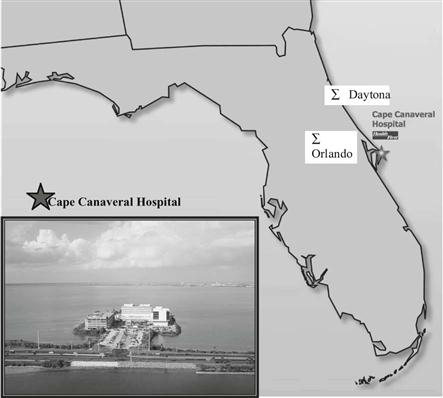Janice M. McCoy and Susan McDonough Stackpoole “The smart thing is to prepare for the unexpected.” —Chinese fortune cookie At Cape Canaveral Hospital, the television announcers are relentless in their coverage of the approaching hurricane. The same message is heard from the TV in every patient’s room: “Evacuate now!” The nursing staff hear the message, but they are focused on patient safety as their patients are loaded into waiting ambulances for the trip to their sister hospital in Melbourne, Florida, which is 35 miles to the south. The wind is increasing, as well as anxiety, as the staff hurry to finish, secure their areas, and evacuate to a safe location to wait out the approaching storm. Hurricanes are a force of nature that challenges many states along the east and gulf coasts of the United States. Florida is especially vulnerable, and every community must be ready to respond quickly to protect its citizens and their property during violent weather. Cape Canaveral Hospital, one of three hospitals in Health First, Inc., is located 1 mile from the Atlantic Ocean in Cocoa Beach, Florida, and is under mandatory evacuation orders when a hurricane approaches from the east (Figure 55-1). Coordinating the evacuation process is a challenge, as patient safety and well-being are primary concerns. Time is a critical factor to ensure that the patients are relocated, the hospital is secured, and employees also have adequate time to prepare their homes and their families for evacuation. All of these things must be completed before the causeways are closed and travel to safety is no longer possible. Multiple hurricane evacuations in recent years revealed problems at Cape Canaveral Hospital. The problems provided an opportunity to develop creative policy solutions. The policies were designed to address nursing staff expectations and responsibilities and to define the consequences of failure to adhere to these policies during hurricanes. The policy goal was to hold employees accountable for their job responsibilities, at a time when the community depends on them, without risking the safety of the employees and their families. Hurricane season begins June 1, but hospital planning and preparations begin every January. Health First, Inc. has a Hurricane Task Force that is composed of representatives from all of the Health First facilities. This interdisciplinary team meets to review the experiences from the previous year and to ensure that all of the policies address any issues that were identified. May is designated as Hurricane Preparedness Month, and all educational activities for staff and physicians are completed during the month. Because of the nature of the preparation process, three planning phases have been defined: pre-storm, during storm, and post-storm. The pre-storm team includes all of the employees who are on duty at the time the evacuation is ordered. Hospital department evacuation plans have been developed that clearly define expectations of the employees. When this plan is activated, discharge or transfer orders for patients are obtained, patients and their health care records are prepared for transfer, and the nursing units are secured and closed down as the patients are discharged or transported to other facilities. Once the unit or department is closed, employees are allowed to leave. All staff members are expected to tell their directors where they will be during the storm and how they can be contacted. The “during storm” team is composed of the employees who are scheduled to work during the shifts when the hospital is closed. This may be only 1 day to 4 or more days, depending on the extent of the damage that occurs at the hospital. The expectation is that employees will report to work at another facility where patients have been transferred to assist the receiving hospital’s staff with the extra workload. It is also expected that employees will report to the facility in advance of the storm to ensure that they are able to reach their destination safely. They are directed to bring enough food, clothes, and personal care items to last for several days. The post-storm team includes employees who are able to return to the hospital as soon as the roads are passable to assess the damage and begin to prepare the facility to reopen. Certain departments arrive first, including security, administration, environmental services, food services, and plant operations, to begin the cleanup and ensure that the hospital is safe for staff and patients. Staff members involved in patient care are notified as soon as it is safe to return to reopen their units and begin the process of returning patients to the facility. A brochure that is updated and distributed each year clearly explains the expectations for the employees, and meetings are held to review the information. Flyers entitled “Hurricane Preparedness Tips” are distributed monthly during hurricane season to all employees to reinforce the information in the brochure. Health First developed a number of forms to clearly communicate the expectations for each individual employee, depending on his or her family situation. The most important form is the employee “During Hurricane Exemption” form (Figure 55-2). This form is used by staff to request an exemption from working before, during, or after the storm. The eligible exemptions include the following:
Taking Action
When a Hurricane Strikes: The Challenge of Crafting Workplace Policy
Annual Preparation Activities
Before the Storm
During the Storm
After the Storm
Employee Expectations
![]()
Stay updated, free articles. Join our Telegram channel

Full access? Get Clinical Tree


Nurse Key
Fastest Nurse Insight Engine
Get Clinical Tree app for offline access


